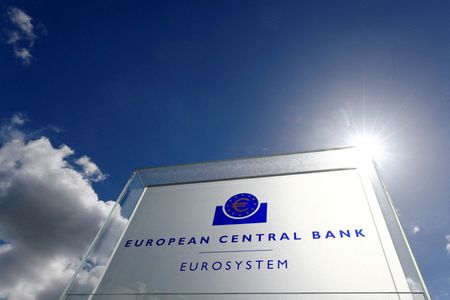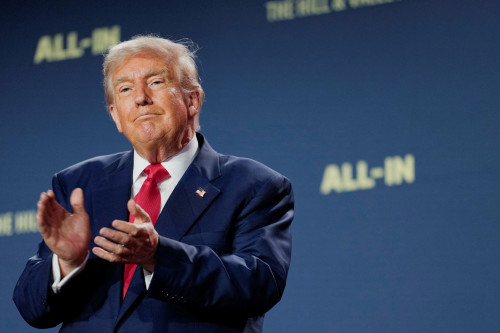By Francesco Canepa
FRANKFURT (Reuters) – The European Central Bank is on the back foot again and this time the bad news doesn’t come from Greece, Italy or any of the usual suspects in the bloc’s poorer south.
The club’s biggest member and supposed powerhouse, Germany, has been hit by a toxic mix of weak trading with key partner China, a slump in its large manufacturing and construction sectors and even some existential questions about a business model predicated on cheap fuel from Russia.
Trouble in Germany is hobbling growth in the euro zone as a whole and threatening to push it into a recession, rather than the “soft landing” of moderate growth and inflation that the ECB had pencilled in and the United States is still hopeful of achieving.
This is forcing a change of tune at the ECB — from ruling out a pause in its steepest and longest streak of interest rate hikes to openly talking about one as soon as next month.
And the market thinks the central bank may even have to undo some of those increases sooner rather than later, just like it did at the time of its last tightening cycle in 2011 when debt crises in Greece, Portugal, Ireland, Spain and Cyprus were accompanied by a broader recession..
“There are some similarities between the 2011 circumstances and now,” Richard Portes, a professor of economics at the London Business School, said. “There was a major supply shock and inflation was clearly going to be very short lived.”
SICK MAN OF EUROPE – AGAIN
Unlike then, Germany rather than the south of Europe is at the epicentre of the problem, bringing many commentators to dust off the “sick man of Europe” moniker last used to refer to that country in the early years of the new century.
It’s not without irony that the expression should have been coined by Emperor Nicholas I of Russia to describe the Ottoman Empire in the 19th century.
Some of Germany’s present misfortunes also originate in Russia, on which Berlin had relied for a third of its energy supply until the invasion of Ukraine jeopardised those cheap imports.
Others run deeper and are home brewed, relating to its over-reliance on exports, lack of investment and shortage of labour.
“If the government does not take decisive action, Germany is likely to remain at the bottom of the growth table in the euro area,” said Ralph Solveen, an economist at Commerzbank.
CAREFUL WHAT YOU WISH FOR
But at least some of Germany’s troubles can be traced back to tighter monetary policy.
The central bank has consciously dampened economic activity via higher rates in an attempt to bring inflation, which at one point last year was in double digits, to its 2% target.
Higher borrowing costs hurt manufacturers particularly hard because they depend on investment and no euro zone country has a larger industrial sector than Germany.
“To loosen monetary policy because Germany is in a difficult position would be unwise but to tighten it would add macro pressure to the micro-level pressures that beset the economy,” Portes added.
This puts the ECB in a situation where it must contemplate wrapping up its tightening cycle before witnessing the sustained drop in core inflation it said it wanted to see.
Making such an explicit link between underlying inflation and the need for continued rate hikes may prove awkward for the ECB, which is now trying to shift the emphasis from raising borrowing costs to simply keeping them high.
“They’ve made a mistake in accentuating underlying inflation too much,” said Carsten Brzeski, global head of macro for ING Research, said. “The risk is that they have already gone too far.”
For Ricardo Reis, a professor at the London School of Economics, the ECB needed to start looking at the expected path of inflation “12 or 18 months from now” — as it traditionally did — rather than current readings.
HIGHER FOR LONGER
The first sign of a change in the narrative started at the ECB’s last meeting two weeks ago and caught markets by surprise.
After declaring in June the ECB was “not even thinking about pausing” its rate hikes, Lagarde changed tack in her latest press conference, going as far as saying she didn’t think the central bank had more ground to cover “at this point in time”.
Days later — and after data showed inflation excluding energy, food, alcohol and tobacco was stuck at 5.5% — the ECB chose to emphasise that most other measures of underlying prices had shown signs of easing.
And ECB board member Fabio Panetta then made the case for “persistence” in keeping rates high rather than raising them further.
All this set the stage for a possible pause in rate hikes in September, likely coupled with an option to come back for more if needed and a pledge to keep borrowing costs elevated for a while.
But markets even doubt the high-for-longer scenario, with substantial rate cuts priced in for the second half of next year.
“We continue to expect the ECB to pivot significantly over the next few months, with no further hikes this year and March kicking off a series of rate cuts,” economists ABN-AMRO said in a note to clients.
(Reporting By Francesco Canepa; editing by Mark John and Christina Fincher)





